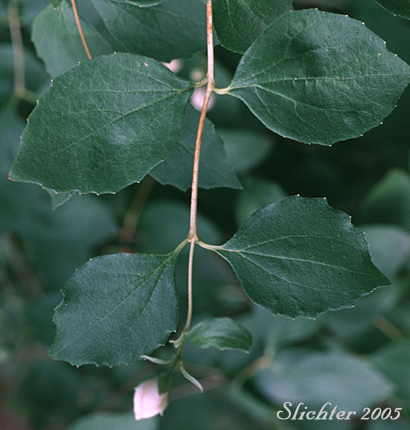 The
photo at right shows a branch tip of mock orange with its paired leaves and a
flower bud at the tip. Photographed at Avery Park in Salem, OR.
The
photo at right shows a branch tip of mock orange with its paired leaves and a
flower bud at the tip. Photographed at Avery Park in Salem, OR.
Mock orange is a beautiful and fragrant shrub named (species name) after Captain Meriwehter Lewis who discovered it in 1804. The genus name honors the ancient Egyptian king "Philadelphus".
Mock Orange is a loosely branched shrub up to 10 feet in height. The overall shape of the shrub is generally rounded. The stems are smooth-surfaced with reddish brown bark on the newer twigs, or a cross-tracked bark on second year growth. The branches and leaves are opposite.
The leaves are simple pinnate with entire leaf margins (possibly serrate on older branches). The leaf shape is ovate-lanceolate, and the leaves have 3 prominent veins arising from the leaf base. Leaves are light green above and pale green below, and range from 2.5-7.5 cm in length.
The numerous flowers are fragrant (like citrus), with 3-11 flowers in a terminal raceme. The 4 showy white petals surround numerous yellow stamens. The flowers are about 3 cm in diameter.
1. Beautiful shrub for the garden.
2. Scent of flowers is sweet and very fragrant. Visit Tom McCall Preserve (east of Mosier, OR) in late May or early June to enjoy the fragrance of this plant.
3. Wood is strong & hard for tools, bows, & arrows, pipes, and combs.
4. Leaves and flowers make a soapy foam when wet for cleaning.
5. It is the state flower of Idaho.
6. It is browsed by deer and elk, and the seeds are eaten by quail and chukar.
Mock orange is found along streams, in dry ravines, and on rocky talus and along canyon rims from the lowlands into the mountains.
Mock orange is found from British Columbia south to northern California and east to central Idaho and western Montana.